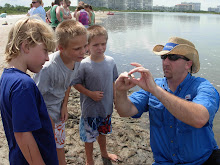 |
Rookery Bay biologist Pat Odonell
records fish measurements
during a sampling trip. |
Today I had the fortunate privilege of accompanying Pat O'Donnell,
Rookery Bay National Estuarine Research Reserve's fish biologist and his volunteers on one of his monthly fish sampling trips in the 10,000 Islands.
Trawls like this are a part of Pat's work to document the affects of altered freshwater flow from past failed development projects (specifically the Southern Golden Gates Project) on fish population dynamics in downstream Pumpkin, Faka, and Fakahatchee Bays. Local Everglades restoration projects are attempting to return these flows to pre-development conditions. Pat's project has been collecting fisheries data for the past 11 years and his baseline data will continue to be monitored throughout the restoration project to enable scientists to measure the changes resulting from restoration efforts. To learn more details about Pat's research project visit
http://www.rookerybay.org/research/restoration-effects-on-fishes
Pat samples three times a month, and what is really cool is he depends on volunteers to assist him in his monitoring efforts. As an educator, I cannot think of a better way to learn first-hand about our local coastal systems. Volunteers go out on Pat's research boat and help pull a trawl net, identify and measure fish. Pat is great at training even novice volunteers collect valuable data. Over the years Pat has accumulated quite a "volunteer army" so if you are interested in going on one of his trips, you usually need to sign up far in advance. If you are interested you can email Pat at
patrick.odonnell@dep.state.fl.us or call him at (239) 417-6310 ext 404. Pat also has a monthly shark tagging project that he depends on volunteers as well. To learn more about this project visit:
http://www.rookerybay.org/research/shark-nurseries
So you get a better idea of what a sampling trip is like, I've provided you plenty of pictures. Enjoy!
 |
| volunteers pulling in the trawl net |
 |
| Volunteers fill up a basin with water; this is where they will empty the day's catch before it gets sorted. |
 |
| An example of fish collected in a trawl. You can see Pat's finger as he identifies fish for volunteers. |
 |
| A fringed flounder |
 |
| Volunteers measuring the length of collected fish. |
 |
| A lined sole |
 |
| An identified polychaete (marine worm) found in some macro algae |
 |
| A juvenile sheepshead |
 |
| An unidentified tunicate |
 |
| The clear "jelly-like" substance is actually a sea cucumber. |
 |
| Two lined sea horses caught in the trawl |
 |
| A beautiful ocellated flounder |
 |
| Hauling in one of four trawls |
 |
| Black-cheeked tonguefish |
 |
| A crowned conch |
 |
| A red mangrove in the 10,000 Islands |





















No comments:
Post a Comment